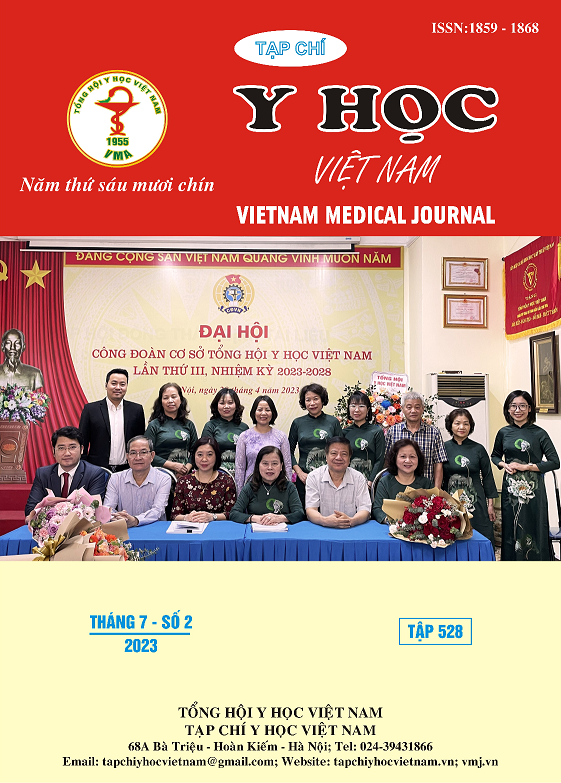THE CLINICAL CHARACTERISTICS AND RELATED FACTORS IN CORONARY ARTERY DISEASE PATIENTS AT DA NANG C HOSPITAL
Main Article Content
Abstract
Objective: To evaluate the relationship between the prevalence of coronary artery lesions in patients with coronary artery disease (CAD) without comorbidities and comorbidities. Subjects and methods: 168 patients with coronary artery disease were treated at the Department of Cardiology at Da Nang C Hospital from December 2021 to December 2022. The study was carried out by cross-sectional descriptive method. Results: The left anterior descending coronary artery lesions (LAD%) in patients without comorbidities was 7/7 (100%); patients with 1 comorbidity was 67/68 (98.5%) and patients with 2 or more comorbidities was 89/93 (95.7%). The left circumflex artery lesions (LCx%) in patients without comorbidities; 1 and more 1 comorbidities; was 2/7 (28.6%), 31/68 (45.6%) and 60/93 (64.5%), respectively. The right coronary artery lesions (RCA%) in patients without comorbidities; 1 and more 1 comorbidities was 2/7 (28.6%), 42/68 (61.8%) and 70/93 (75.3%) respectively. The prevalance of CAD without comorbidities had 1 lesion branche, accounting for 57.1%; 2 branches (28.6%) and 3 branches (14.3%). The patient had 1 comorbidity corresponding to the rate of 30.9%; 32.4% and 36.8%. Patients with 2 or more comorbidities, corresponding to the rate of 23.2%; 33.3% and 43.5%. Conclusion: There was a statistically significant difference between CAD with and without comorbidities with the rate of LCx(%) lesions (p=0.019); RCA(%) (p=0.017) and number of lesion branches (p=0.029). There was no difference between cad with and without comorbidities and with the LAD (%) lesion rate
Article Details
Keywords
Coronary artery disease; CAD, LAD%; LCx%; RCA%
References
2. Benjamin, Emelia J., et al. "Heart disease and stroke statistics—2019 update: a report from the American Heart Association." Circulation 139.10 (2019): e56-e528.
3. Phạm Hồng Phương, Phạm Mạnh Hùng, Vũ Điện Biên. "Đánh giá sự liên quan giữa bệnh gan nhiễm mỡ không do rượu với tổn thương động mạch vành ở các bệnh nhân được chụp động mạch vành." Journal of 108-Clinical Medicine and Phamarcy (2018), 13 (2).
4. Nguyễn Phi Anh (2014). Nghiên cứu chức năng thất trái bằng phương pháp siêu âm Doppler mô cơ tim ở bệnh nhân bệnh tím thiếu máu cục bộ mạn tính trước và sau điều trị tái tưới máu. Luận án Tiến sĩ y học. Đại học Y Hà Nội
5. Vũ Kim Chi (2013). Nghiên cứu giá trị phương pháp chụp cắt lớp vi tính 64 dãy trong chẩn đoán bệnh lý động mạch vành. Luận án tiến sĩ y học. Đại học Y Hà Nội.
6. Hosseini K, Mortazavi SH, Sadeghian S, Ayati A, Nalini M, Aminorroaya A, Tavolinejad H, Salarifar M, Pourhosseini H, Aein A, Jalali A. Prevalence and trends of coronary artery disease risk factors and their effect on age of diagnosis in patients with established coronary artery disease: Tehran Heart Center (2005–2015). BMC cardiovascular disorders. 2021 Dec;21:1-1.
7. Trần Thị Trúc Linh (2016), Nghiên cứu mối liên quan giữa biểu hiện tim với mục tiêu theo khuyến cáo ESC-EASD ở bệnh nhân đái tháo đường type 2 có tăng huyết áp. Luận án Tiến sĩ y học. Đại học Y dược, Đại học Huế.
8. Mishra S, Ray S, Dalal JJ, Sawhney JP, Ramakrishnan S, Nair T, Iyengar SS, Bahl VK. Management standards for stable coronary artery disease in India. Indian Heart Journal. 2016 Dec 1;68:S31-49.


